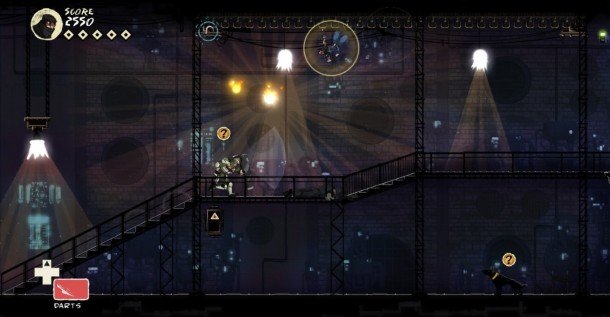The five rules of stealth game design, according to Mark of the Ninja designer Nels Anderson

In a talk with Gamasutra , Mark of the Ninja lead designer Nels Anderson outlined his five stealth design guidelines, which he's dubbed the "heresies of the ninja." Anderson has a sturdy platform on which to talk about the genre: Mark of the Ninja's sidescrolling stealth was critically acclaimed, and despite only having played a couple hours of it, I've already recommended it to everyone within talking range. It seems successful execution of Anderson's recipe makes a very tasty stealth pie (but don't try to actually eat it, it's full of deadly poison and snapped necks).
Anderson's first two rules demand game logic transparency. In Mark of the Ninja, you're either lit or shadowed, sounds send out visual pings, and guards' behaviors won't change without a signal indicating their level of awareness. The suggestion is that this encourages "intentional play"—empowering players with complete feedback so they can predict outcomes and make informed decisions. Squashing trial-and-error guesswork also supports Mark of the Ninja's fiction. "...The player is a ninja, and if you are constantly bumbling through it kind of undermines the thing we're going for," said Anderson.
Rule three serves the same purpose by limiting reliance on motor skills so that players can execute the maneuvers they want to execute, rule four limits consequences for failure to duck the tedium of replaying slow-paced stealth sections, and rule five specifically targets 2D games, limiting the openness of the world to ease navigation through the unnatural environment of a sidescroller.

One of Anderson's most interesting observations is about the way players deal with checkpoints and failure. "With Ninja, it basically had a checkpoint between every meaningful encounter," he said. "This allowed us and the player more experimentation in the game. You've all heard of degenerative strategies, where people have worked out one thing that works and it's boring as hell, but they keep doing it because they don't want to lose work. They don't want to lose the last six, seven minutes of play so they just keep doing that boring thing."
Actually, I hadn't heard the term "degenerative strategies" before, but we've definitely discussed the phenomenon. In general, it seems that punishing failure with lost progress as a way to establish difficulty is a fading technique. I prefer Anderson's philosophy. Repetition of new, meaningful encounters, and not the stuff we already figured out, encourages experimentation over tedious caution. Getting quicksaves back in most PC games is probably too much to ask for, but I can settle for frequent checkpointing or compressed, Hotline Miami-style levels. That's with exceptions, of course: the fear of losing progress in FTL, for example, is a necessary part of the experience.
Anderson has a lot of interesting ideas, so definitely check out Gamasutra's article .
Keep up to date with the most important stories and the best deals, as picked by the PC Gamer team.

Tyler grew up in Silicon Valley during the '80s and '90s, playing games like Zork and Arkanoid on early PCs. He was later captivated by Myst, SimCity, Civilization, Command & Conquer, all the shooters they call "boomer shooters" now, and PS1 classic Bushido Blade (that's right: he had Bleem!). Tyler joined PC Gamer in 2011, and today he's focused on the site's news coverage. His hobbies include amateur boxing and adding to his 1,200-plus hours in Rocket League.

